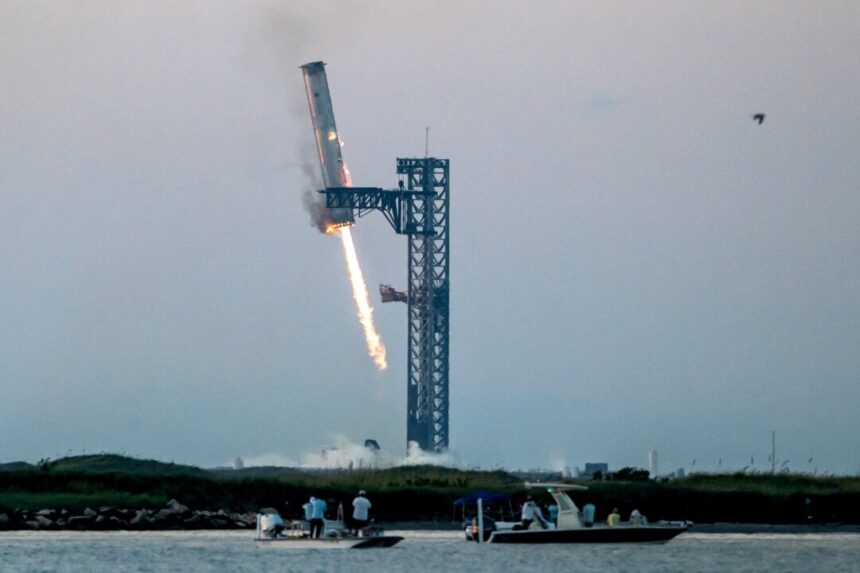Elon Musk’s vision for SpaceX is to become the first company to create a reusable spaceship and rocket, ultimately aiming to transport people to the moon and Mars.
During SpaceX’s fifth Starship test flight, the giant booster successfully returned to the launch pad using mechanical arms.
The “Super Heavy” booster’s first stage took off from SpaceX’s Boca Chica, Texas, launch site, propelling the Starship second stage rocket into space before separating at an altitude of approximately 40 miles. The most daring part of this test flight was the booster’s return to land.
The Super Heavy booster utilized three of its 33 Raptor engines to slow down its descent back to the launch site, precisely targeting the launch pad and tower it had departed from. The tower, standing over 400 feet tall, is equipped with two large metal arms at the top.
With its engines active, the 233-foot-tall Super Heavy booster landed in the launch tower’s arms, securing itself in place using small bars under the four forward grid fins it had used for navigation.
“The tower has caught the rocket!!” exclaimed CEO Elon Musk on X following the successful catch.
SpaceX employees celebrated with screams of joy, while NASA Administrator Bill Nelson also extended congratulations, noting that continued testing of Starship will pave the way for human landings on the moon’s south pole as part of NASA’s Artemis program.
The innovative catch-landing method represents a significant advancement in SpaceX’s efforts to develop a fully reusable rocket capable of carrying more cargo into orbit, transporting astronauts to the moon for NASA, and eventually reaching Mars, as envisioned by Musk.
Meanwhile, the Starship second stage, launched by the booster, completed a journey around the world, reaching over 130 miles in altitude. It executed a controlled landing in the Indian Ocean an hour after liftoff, further demonstrating SpaceX’s capabilities.
SpaceX proceeded with the ambitious Starship rocket test flight following approval from the Federal Aviation Administration (FAA).
For the fifth test flight, Starship underwent significant upgrades to its heatshield system, including the replacement of older tiles with newer-generation tiles, ablative layers, and additional protections for reentry and landing.
FAA Delays
Despite previous delays, the FAA’s approval on Saturday was earlier than anticipated. SpaceX had faced obstacles due to changes in the flight profile that required additional review for environmental impact.
SpaceX’s commitment to ensuring public safety while pushing the boundaries of rocketry makes each test flight a unique and groundbreaking operation. The company’s dedication to innovation and risk management has been evident in its approach to the Starship program.
The third test in March marked a significant milestone for SpaceX as the Starship successfully made it to space. However, the test ended in disappointment as SpaceX lost contact with the spacecraft upon its return near the Indian Ocean.
NASA has already placed orders for two Starships, with plans to use them to land astronauts on the moon as part of the Artemis program in the coming years. The collaboration between NASA’s own rocket and capsule with SpaceX’s Starship will facilitate safe travel for moon crew members.
Elon Musk envisions the Starship eventually replacing SpaceX’s Falcon 9 rocket, which is currently a mainstay in the company’s launch operations. SpaceX’s successful track record in launching satellites and commercial payloads into space positions the Starship as a promising successor.
Contributions to this report were made by Reuters and The Associated Press.
Source link






